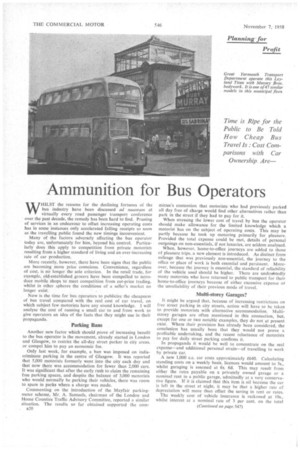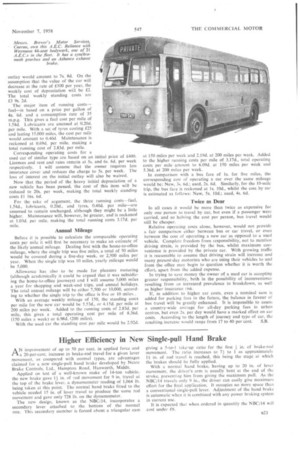Ammunition for Bus Operators
Page 94

Page 97

If you've noticed an error in this article please click here to report it so we can fix it.
Time is Ripe for the Public to Be Told How Cheap Bus Travel Is : Cost Comparisons with Car
Ownership Are— WHILST the reasons for the declining fortunes of the bus industry have been discussed ad nauseant at virtually every road passenger transport conference over the past decade, the remedy has been hard to find. Pruning of services in an endeavour to offset increasing operating costs has in some instances only accelerated falling receipts so soon as the travelling public found the new timings inconvenient.
Many of the factors adversely affecting the bus operator today are, unfortunately for him, beyond his control. Particularly does this apply to competition from private motorists resulting from a higher standard of living and an ever-increasing rate of car production.
More recently, however, there have been signs that the public are becoming more price conscious. Convenience, regardless of cost, is no longer the sole criterion. In the retail trade, for example, old-established grocers have been compelled to introduce mobile shops to meet competition from cut-price trading, whilst in other spheres the conditions of a seller's market no
longer exist. .
Now is the time for bus operators to publicize the cheapness of bus travel compared with the real cost of car travel, on which subject few motorists have any sound knowledge. I will analyse the cost of running a small car to and from work to give operators an idea of the facts that they might use in their propaganda.
Parking Bans
Another new factor which should prove of increasing benefit to the bus operator is the movement, already started in London and Glasgow, to restrict the all-day street parker in city areas, or compel him to pay an economic fee.
Only last week, for example, a ban was imposed on indiscriminate parking in the centre of Glasgow. It was reported that 5,000 motorists formerly went into the city each day and that now there was accommodation for fewer than 2,000 cars. It was significant that after the early rush to claim the remaining free parking spaces, and despite the balance of 3,000 motorists who would normally be parking their vehicles, there was room to spare in parks where a charge was made.
Commenting on the introduction of the Mayfair parkingmeter scheme, Mr. A. Samuels, chairman of the London and Home Counties Traffic Advisory Committee, reported a similar situation. The results so far obtained supported the com B20
mittee-s contention that motorists who had previously parked all day free of charge would find other alternatives rather than park in the street if they had to pay for it.
When stressing the lower cost of travel by bus the operator should make allowance for the limited knowledge which a motorist has on the subject of operating costs. This may be partly because he took up motoring primarily for pleasure. Provided the total expense could be met, details of personal outgoings on non-essentials, if not luxuries, are seldom analysed.
When, however, home-to-office journeys are added to those of pleasure trips, a new element is introduced. As distinct from mileage that .was previously non-essential, the journey to the office or place of work is both essential and persistent. Moreover, because the journey is essential, the standard of reliability of the vehicle used should be higher. There are undoubtedly many motorists who have returned to public transport for their home-to-office journeys because of either excessive expense or the unreliability of their previous mode of travel.
Multi-storey Garages?
It might be argued that, because of increasing restrictions on free street parking in city streets, action will have to be taken to provide motorists with alternative accommodation. Multistoreygarages are often mentioned in this connection, but, except for one or two notable examples, they do not at present exist. Where their provision has already been considered, the conclusion has usually been that they would not prove a profitable undertaking, and the recent reluctance of motorists to pay for daily street parking confirms it.
In propaganda it would be well to concentrate on the real expense—and additional personal strain—of travelling to work by private car.
A new 1,000 c.c. car costs approximately £640. Calculating standing costs on a weekly basis, licences would amount to 5s., whilst garaging is assessed at 6s. 6d. This may result from either the rates payable on a privately owned garage or a nominal rent in a public garage, admittedly at a very conservative figure. If it is claimed that this item is nil because the car is left in the street at night, it may be that a higher rate of depreciation will more than offset the saving in rent or rates.
The weekly cost of vehicle insurance is reckoned at 10s., whilst interest, at a nominal rate of 3 per cent. on the total
outlay would amount to 7s. 8d. On the assumption that the value of the car will decrease at the rate of £100 per year, the weekly cost of depreciation will be £2. The total weekly standing costs are £3 9s, 2d. The major item of running costsfuel—is based on a price per gallon of 4s. 6d. and a consumption rate of 35 m.p.g. This gives a fuel cost per mile of I.54d. Lubricants are assessed at 0.20d. per mile. With a set of tyres costing £25 and lasting 15,000 miles, the cost per mile would amount to 0.40d. Maintenance is reckoned at 0.69d. per mile, making a total running cost of 2.83d. per mile.
Corresponding operating costs for a used car of similar type are based on an initial price of 1400. Licences and rent and rates remain at 5s. and 6s. 6d. per week
respectively. will assume that the owner requires less insurance cover and reduces the charge to 5s. per week. The loss of interest on the initial outlay will also be waived. Now that the period of the heavy initial depreciation of a new vehicle has been passed, the cost of this item will be reduced to 20s. per week, making the total weekly standing costs £1 16s. 6d. For the sake of argument, the three running costs—fuel, 1.54d., lubricants, 0.20d., and tyres, 0.40d. per mile—are assumed to remain unchanged, although they might be a little higher. Maintenance will, however, be greater, and is reckoned at 1.03d. per mile, making the total running costs 3.I7d. per mile.
Annual Mileage Annual Mileage Before it is possible to calculate the comparable operating costs per mile it will first be necessary to make an estimate of the likely annual mileage. Dealing first with the home-to-office mileage, where the single trip was five miles, a total of 50 miles would be covered during a five-day week, or 2,500 miles per year. When the single trip was 10 miles, yearly mileage would be 5,000. Allowance has also to be made for pleasure motoring (although academically it could he argued that it was subsidizing the home-to-office journeys) and I will assume 5,000 miles a year for shopping and week-end trips, and annual holidays. The total annual mileage will be either 7,500 or 10,000, according to whether the single trip to the office is five or 10 miles.. With an average weekly mileage of 150, the standing costs per mile for the new car would be 5.53d., or 4.15d. per mile at 200 miles per week. Added to the running costs of 2.83d. per mile, this gives a total operating cost per mile of 8.36d. (150 miles a week) or 6.98d. (200 miles),
With the used car the standing cost per mile would be 2.92d.
at 150 miles per week and 2.19d. at 200 miles per week, Added to the higher running costs per mile of 3.17d., total operating costs per mile amount to 6.09d. at 150 miles per week and 5.36d. at 200 miles per week. In comparison with a bus fare of Is. for five miles, the corresponding cost of operating a car over the same mileage would be: New, 3s. 6d.; used, 2s. 6d. Similarly, for the 10-mile trip, the bus fare is reckoned at Is. 10d., whilst the cost by car is estimated as follows: New, 5s. 10d.; used, 4s. 6d.
Twice as Dear
m
In all cases it would be ore than twice as expensive for only one person to travel by car, but even if a passenger were carried, and so halving the cost per person, bus travel would still be cheaper. Relative operating costs alone, however, would not provide a fair comparison either between bus or car travel, or even between the cost of operating a new car as opposed to a used vehicle. Complete freedom from responsibility, not to mention driving strain, is provided by the bus, whilst maximum convenience is provided by the private car. With growing traffic it is reasonable to assume that driving strain will increase and many present-day motorists who are using their vehicles to and from the office may begin to question whether it is worth the effort, apart from the added expense. In trying to save money the owner of a used car is accepting greater responsibility, both in the possibility of inconvenience resulting from an increased prevalence to breakdown, as well as higher insurance risk. If, in addition to higher car costs, even a nominal sum is added for parking fees in the future, the balance in favour of bus travel will be greatly enhanced. It is impossible to assess a country-wide average for all-day parking fees in urban centres, but even 2s. per day would have a marked effect on car costs. According to the length of journey and type of car, the resulting increase would range from 17 to 40 per cent. S.B.












































































































































